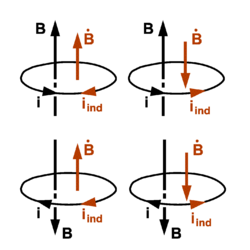Lenz' law
In electromagnetism Lenz' law states that a change in magnetic flux Φ (magnetic induction B integrated over a surface S, see this article) gives an induced current that opposes the change in flux.
For the sake of argument we consider the case of a time-dependent magnetic induction B(t) passing through a time-independent surface S. Further we assume that B(t) does not vary over the surface. According to Faraday's law of magnetic induction the time derivative of B(t)
induces a current iind in a conducting loop. The direction of iind is such that the change in field B(t) is opposed. The different cases are illustrated in the figure on the right. Recall here that the direction of current i and field B are connected through the right-hand screw rule, that is, a screw is driven in the direction of B and rotated in the direction of i.
The law is named for the Estonian physicist Heinrich Friedrich Emil Lenz (1804 – 1865).


